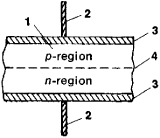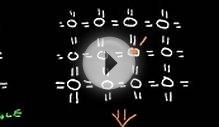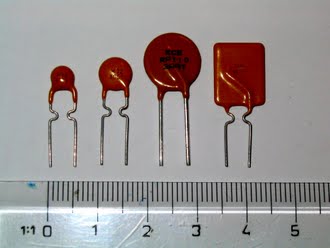A two-electrode electronic device based on a semiconductor crystal. The term is applied to various devices that have different principles of operation and different uses. Semiconductor diodes are classified according to the general classification system for semiconductor devices. The most widespread class is that of electric-conversion semiconductor diodes, which includes rectifier diodes, pulse diodes, voltage-stabilizing diodes, and microwave diodes such as video detectors, mixer diodes, parametric diodes, amplifier diodes, oscillator diodes, multiplier diodes, and switching diodes. Examples of optical electronic semiconductor diodes are photo-diodes, light-emitting diodes, and semiconductor lasers.

Figure 1. Structure of a semiconductor diode with a p-n junction: (1) crystal, (2) terminals (contact conductors), (3) electrodes (ohmic contacts), (4) plane of the p-n junction
The most numerous semiconductor diodes are those whose operation is based on the properties of a p-n junction. If a forward voltage, or forward bias, is applied to a p-n junction diode (Figure 1)—that is, if a positive potential is supplied to the p- region of the junction—the potential barrier at the junction is lowered, and there begins an intensive injection of holes from the -region into the n-region and of electrons from the -region into the -region. A high forward current results (Figure 2). In the case of a reverse bias, where the voltage is applied in the reverse direction, the potential barrier is raised, and only a very small reverse current of minority carriers flows across the p-n junction. Figure 3 shows the equivalent circuit for such a semiconductor diode.
Figure 2.
Note on Figure 2. Typical volt-ampere characteristic of a semiconductor diode with a p-n junction: () voltage across the diode, () current through the diode, maximum permissible reverse voltage, current corresponding to stabilization voltage
The operation of rectifier power diodes is based on a pronounced asymmetry of the volt-ampere characteristic. Semiconductor diodes for rectifying devices and for other high-current circuits are manufactured for permissible rectified currents Ir of up to 300 amperes (A) and for maximum permissible reverse voltages *rev from 20–30 volts (V) to 1–2 kilovolts (kV). Semiconductor diodes for similar applications in low-current circuits have an Ir of less than 0.1 A and are called general-purpose diodes. At voltages greater than *rev. the current rises drastically, and an irreversible (thermal) breakdown of the p-n junction occurs that results in the breakdown of the diode.
In order to increase *rev to several tens of kV, rectifier stacks are used. In such a stack, several identical rectifying semiconductor diodes are connected in series and are mounted in a common plastic casing. The time lag exhibited by rectifier diodes depends on the lifetime of the injected holes, which is greater than 10-5-10-4 sec. This time lag limits the frequency range within which semiconductor diodes can be used to, usually, 50 to 2, 000 hertz.
The use of special techniques—primarily the doping of germanium and silicon with gold—has permitted a reduction in the switching time to 10-7—10–10 sec and the construction of fast-acting pulsed semiconductor diodes. Such diodes, as well as diode matrices, are used mostly in the low-current signal circuits of electronic computers.
Figure 3. Small-signal (for low signal levels) equivalent circuit of a semiconductor diode with a p-n junction: (rp-n) nonlinear resistance of the p-n junction; (rb) bulk resistance of the semiconductor (diode base); (leak) surface-leakage resistance; (CB) barrier capacitance of the p-n junction; (dif) diffusion capacitance, which is caused by the accumulation of mobile charges in the base when a forward voltage is applied; (o) casing capacitance; (r) inductance of contact conductors; () and () terminals. The solid lines show the connections of elements that are part of the p-n junction proper.
If the breakdown voltages are low, there usually occurs not a thermal breakdown but a reversible avalanche breakdown of the p-n junction, that is, an abrupt increase of current at an almost constant voltage called the stabilization voltage st. The operation of semiconductor voltage-stabilizing diodes is based on this kind of breakdown. General-purpose voltage-stabilizing diodes with a st from 3–5 V to 100–150 V are used predominantly in regulators and limiters of constant and pulsed voltages. Precision voltage-stabilizing diodes can be provided with compensating elements to achieve exceptionally high temperature stability of St, (up to 1 × 10-5-5 × 10-6 per degree Kelvin). Such voltage-stabilizing diodes are used as sources of reference voltages.
The reverse current of a diode is subject to considerable fluctuations in the prebreakdown region. This property of the p-n junction is made use of to construct noise generators. The time lag during the development of an avalanche breakdown in a p-n junction is 10-9-10–10 sec. It leads to a phase shift between the current and the voltage in the diode and thus can cause the generation of ultrahigh-frequency oscillations if the diode is connected to an appropriately designed electric circuit. This property has been successfully made use of in avalanche transit time diodes, which have permitted the construction of oscillators with frequencies up to 150 gigahertz.
Mixer diodes and video detectors are used for the detection and conversion of electric signals in the microwave region. In most of these devices the p-n junction is formed under a point contact. This design provides a low value of the capacitance CB (Figure 3). Also, as in all microwave diodes, structural features that are specific to each type provide low values of the parasitic inductance Lc and capacitance Cc and permit the diode to be installed in wave-guide systems.
RELATED VIDEO


 A polymeric positive temperature coefficient device (PPTC, commonly known as a resettable fuse, polyfuse or polyswitch) is a passive electronic component used to protect against overcurrent faults in electronic circuits. They are actually non-linear thermistors...
A polymeric positive temperature coefficient device (PPTC, commonly known as a resettable fuse, polyfuse or polyswitch) is a passive electronic component used to protect against overcurrent faults in electronic circuits. They are actually non-linear thermistors...
 A thermostat is a component of a control system which senses the temperature of a system so that the system's temperature is maintained near a desired setpoint. The thermostat does this by switching heating or cooling devices on or off, or regulating the flow of a...
A thermostat is a component of a control system which senses the temperature of a system so that the system's temperature is maintained near a desired setpoint. The thermostat does this by switching heating or cooling devices on or off, or regulating the flow of a...